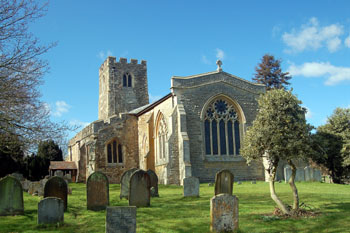
Church from the south-east March 2008
Volume 81 published by Bedfordshire Historical Records Society (2002) is a series of episcopal visitations edited by former County Archivist Patricia Bell. At each visitation a list of questions was sent out in advance, one of which enquired about the provision of schools in each parish. The various replies were as follows:
- 1706: "There is no Lecture, Schole, Almsehouse, or Hospital endowed within this parish";
- 1712: "Catechizing not often, few have learnt their Catechism. A schole is new set up to remedy that defect";
- 1717: "Only a Private School";
- 1720: "Schools: No".
Bedfordshire & Luton Archives & Records Service holds a report by James Lilburne to Samuel Whitbread II in 1802 about a number of Bedfordshire schools, including Old Warden [W1/849], of which he says: "Bunting's School consists of 12 Boys who are taught to Read & wright [sic], but when I visited it in March there was but very few attending; The annual expence [sic] of it is about £8/8/-. Bunting's Sunday School consists of between 30 & 40 children who are taught to Read and pretty regularly attend the expence of which per Annum is about £7".
In 1818 a Select Committee was established to enquire into educational provision for the poor. This was no doubt prompted, in part, by the recent foundation of two societies promoting education and specifically the building of schools. The Society for Promoting the Lancasterian System for the Education of the Poor was established in 1808 promoting schools run along the lines pioneered by Joseph Lancaster, who had himself copied those of Dr.Andrew Bell, in which older children taught their younger fellows. The Society was renamed the British and Foreign School Society in 1814,. It was supported by a number of prominent nonconformists, Lancaster himself was a Quaker, and sought to teach a non-sectarian curriculum. In answer to this perceived nonconformist takeover of local education the National Society was firmed in 1811 to encourage the teaching of poor children along Anglican lines, including the catechism. The Select Committee sent a questionnaire to all parishes in the country asking for: particulars relating to endowments for the education of children; other educational institutions; observations of parish needs etc. The Old Warden return is combined with that for Southill, but separately noted as follows: "A national school at Old Warden, capable of containing 70 children, but at present onlyattended by about 35. A Sunday school, in which 80 children receive instruction, and three village schools, where about 15 children are taught in each". In those days a Sunday School was just that, a school which met on a Sunday, usually in the church or nonconformist chapel or other similar building, teaching more than the religious topics with which they are associated today. This "national school" must have been created around this time, though no exact evidence exists; it was almost certainly not a National School, however, as no record exists of an affiliation to the National Society, it is therefore usually called simply a Church School.
In the country generally the number of schools built continued to grow over the next fifteen years so that by 1833 the government agreed to supplement the work of the two societies, and local benefactors, by making £20,000 per annum available in grants to help build schools. It also prompted another questionnaire to be sent to each parish in England asking for details of local educational provision. The return from Old Warden states: "One Daily School, containing 36 females (this is, presumably, the Church School, though why it now simply taught girls is not stated, unless this is an error of some kind). One Sunday School, of 30 males and 45 females; both supported by two subscribers. There are several Lace and Plait Schools, in which about 35 children are instructed, and also taught to read; supported by payments from the parents".
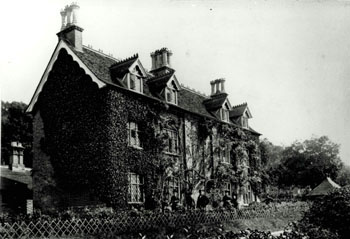
24 and 25 High Street former parish workhouse about 1900 [Z50/129/111]
The next national enquiry was in 1846/7 when the Church of England made an enquiry as to all its church schools. This was against the background of a new Whig government which championed secular education and the increasing importance of nonconformists, particularly Wesleyan Methodist, and Roman Catholics in providing schools. The Old Warden return stated that there was an infants' daily school for 30 boys and 40 girls (presumably the Church or "National" School) and a Sunday School for 50 boys and 70 girls. In addition "Lord Ongley's" day school had 11 boys and 16 girls; a girls' daily school had 16 and a boy's daily school the same number. This school was probably the one which stood at the south-east corner of the modern 24 and 25 High Street which houses were, until 1837, used as the parish workhouse. They were conveyed to Joseph Shuttleworth by the vicar, churchwardens and trustees of the Old Warden Charity Estate and Edward Peake's Charity in Old Warden and by the Official Trustee of Charity Lands in 1876 for £700 and described as a house, formerly used as a workhouse, but now occupied as five tenenemts and a building on the south east side thereof for many years used as a parish schoolroom" [SL1/107].
The first Education Act was passed in 1870 (more correctly it was known as the Elementary Education Act). It was a milestone in the provision of education in Britain demonstrating central government's unequivocal support for education of all classes across the country. It also sought to secularise education by allowing the creation of School Boards. These were groups of representatives, elected by the local ratepayers and the Board had the powers to raise funds to form a local rate to support local education, build and run schools, pay the fees of the poorest children, make local school attendance compulsory between the ages of 5 and 13 and could even support local church schools, though in practice they replaced them, turning them into Board run schools (known as Board Schools). Naturally, and luckily for local historians, the Act required a questionnaire of local schools in 1870; that for Old Warden recorded that there was "no efficient school" and that "a school for 88 children in Old Warden" was required. The return remarked: "If the school for which application for a building grant has been made be completed, no further accommodation will be required". Directory evidence is that this new National School was opened in 1875 (logbooks run only from 1891 [SDOldWarden1-4]) and evidence shows that the old Church School was sold in 1876 to Joseph Shuttleworth [SL1/107].

Proposed additions to school - elevation - 1894 [SL5/177]
The Shuttleworth family were very involved with the school. They gave an annual school treat held in the Park. The following extracts from the school logbook [SDOldWarden1] show a range of the ways in which they were involved:
- May 28th 1891: "Rev F Bourdillon visted this afternoon. Before leaving I showed him the boys’ playground and he has promised to see Major Shuttleworth with a view to having it properly drained and raised one end".
- December 24th 1891: "Mrs Shuttleworth visited this afternoon. Each child presented with a mince pie before leaving".
- April 14th 1892: "As it is usual for Mrs Shuttleworth to distribute buns to the children before breaking up for Easter, I may find it necessary to shorten the last lesson a few minutes".
- July 21st 1892: "Mrs Shuttleworth visited this morning and took scripture".
- November 4th 1892: "Mrs Shuttleworth visited during the last lesson this morning; listened to Geography lesson and gave promise of a new map of England and Wales".
On June 2nd 1900 the children were given the afternoon off school to attend the funeral of Mrs Caroline Shuttleworth who had died from influenza. [SDOldWarden1]. The logbooks also record some of the dramas of school life such as changes in staff: August 8th 1892 "Just previous to the closing of the committee meeting, to my astonishment I was told the Committee had unanimously decided to have a change in the Mastership. I have therefore no choice but to send in my resignation. The above notice, coming so suddenly, and the Committee refusing to give me any reason whatever, I feel thoroughly unfit for work. The work, however, will be carried on as usual, according to the timetable". [SDOldWarden1].
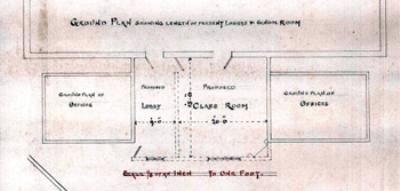
Proposed additions to school - plan 1894 [SL5/177]
A land mark Education Act was passed in 1902, coming into effect in 1903. It disbanded the School Boards and gave day to day running of education to newly formed Local Education Authorities, usually the county council, as in Bedfordshire. The old Board Schools thus became Council Schools whilst the old National, British and other non-Board schools became known as Public Elementary Schools. As a former National School, Old Warden became a Public Elementary School
Bedfordshire & Luton Archives & Records Service has a scrapbook of cuttings of visits made to most Bedfordshire Schools by School Inspectors for a period from just before the First World War through the inter-war years [E/IN1/1]. The first of these reported inspections at Old Warden was in 1909: "The main room, in spite of the new grate liberally provided by the Managers, is still intolerably cold during the winter months. Further provision for warming it should be made before next winter. The Offices [toilets] are dark, ill-ventilated and of a insantiary kind. They are, moreover, far too close to the School-room. The new desks in the main room are of an excellent pattern and well suited to the youngest children but too small and so ill-suited to all the others. The desks in the Infants' Room on the other hand, are too high for Infants and, moreover, are unprovided with backs". In the margin is a note by the Local Education Authority: "Probably an exchange of desks can be effected when new desks are presently required at some other school in the county".
The first report on the state of teaching and learning at the school was in 1911: "The older scholars are in satisfactory order and on the whole they make creditable progress. One of the best features in the work of the School is the Composition which is decidedly good…The Infants Class is in a creditable condition but the teaching of Number should improve. The new arrangements for warming the rooms are a great improvement". The situation with the desks had not improved, however: "Attention is called to the last paragraph of the Report of two years ago".
The first inspection after the Great War was in 1919: "Owing to a decline in the average attendance the staff has been reduced and the Head Master is now without asistance in teaching the older children. Such a task, though difficult, should not be beyond the powers of a vigourous teacher abreast of modern educational developments, but the Head Master has worked here for many years, and although some features in the work of the children are quite creditable, the general level of attainment is not nearly as high as it ought to be". Later that year another visit was made: "Since the last report dated 7th March, 1919, a monitress has been appointed to help with the lower section of the Mixed Division, but the school shews no progress and is in fact weaker than before, partly because the best children have left. The older children shewed some knowledge and interest when questioned on Hygiene, and did not appear to be devoid of natural intelligence; but of Geography and History they knew little, their Arithmetic was poor, and even their Reading and Composition were not as good as they ought to have been. The Drawing was valueless. Six children in Standard I were promoted from the Infants' Division last easter, but were returned in September. They are at present in a lamentable state of backwardness. This makes the future of the school a matter of grave concern, and it is evident that serious steps will have to be taken to save it from inefficiency. The teachers appear to do their best, but there is some want of harmony of effort, and, with the Staff as at present constituted, there is little hope of improvement". The central government Board of Education remarked: "The Board should be informed what steps it is proposed to take to remedy the defects disclosed in the Report, and to secure the efficiency of the School". A marginal note by the LEA reads: "The staff consists of: J.G.Wall, H[ead] T[eacher], Miss Endersby, Sup[ply Teacher], Miss Cooper Mon[itress]. This is sufficient for an average attendance of 55 scholars. The average attendance for the period since 1st April, 1919, is 39".
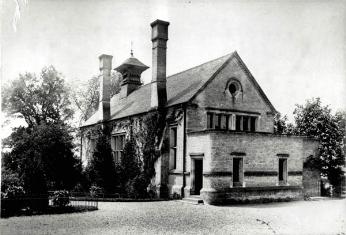
Former Old Warden School about 1900 [Z50/129/98]
The next report is dated 1921, when average attendance remained at 39 when the inepctor noticed "some slight improvement" in the junior scholars' knowledge of Reading, Composition and Arithmetic but "little, if any" in History, Geography, Object Drawing and Singing. Furthermore: "The condition of the Infants' Division is unsatisfactory and the children's progress has been by no means adequate". He also criticised the Needlework: "The girls have done no cutting out and have no knowledge of the reasons for the different processes. The actual sewing is only fair and some of the work is dirty". He went on to observe of Miss Endersby who taught the infants and younger juniors: "Except for a year's service as Monitress in this school in 1902, she has had no previous experience so that it would be unreasonable to expect a high degree of efficiency in her share of the work, seeing that in this the Head Teacher can give her little help. Under the present circumstances, therefore, she should be replaced by a qualified assistant". Next year the inspector returned and found an improvement in Reading and some in Arithmetic, Composition and Drawing, however, History, Geography and Singing remained as bad as before; "As regards the Infants': they are not quite so hopeless as they were but they are a year behind….The present teacher will probably improve matters. As she has been here but a fortnight, she has not had time to leave her mark on the Needlework for the Girls or on the instruction of the Infants". Overall: "It cannot be denied that the School is not a good one".
Given the poor state of the school another visit was made the next year, 1923, and found: "There is little change to chronicle in the condition of the upper section of this school, which is still suffering from poor preparation in the past. The standard is usually one or two years lower than the normal. The new Infants' Teacher has done well in the Reading and other work of this class. Needlework is now taught on much better lines; it is cleaner and some useful work is done". The next year's report marked a sea change: "This School is fortunate in its new Head Teacher. When she came last january its general condition bordered on inefficiency; but she has already brought about a most remarkable change. The discipline is excellent, and the children, under thoroughy capable and sympathetic teaching, are learning to work, and are making good progress. A sound foundation is now being laid in the Infants' Class and in the lower Standards, and there is every reason to regard the future of the School with great hopefulness".
The next report was not until 1933, when average attendance was just 20,when the inspector was able to report: "This Junior School is doing extremely good work, notwithstanding the handicap of epidemic sickness…The Teacher deserves much credit for the work of the children, whose manners and behaviour in school are very good". The final report in the book dates to 1937: "The numbers here now have reached 23…It is well managed by the singlehanded Head Teacher…A Special Place was obtained in a Bedford Secondary School, for the first time from this School in recent years, last year"
The Second World War brought changes to the school. On the 12th September 1939 the logbook [SDOldWarden2] records that: "The three London teachers and the two permanent teachers have spent the day in school arranging classes and making preliminary arrangements for the timetable. Mrs Shuttleworth has kindly allowed the use of her Women’s Institute Hut for schooling purposes". The next day the school reopened. "Senior village children normally attending Shefford Senior School have returned here. Evacuees are classed in two groups; those staying with friends or relations are to be entered as Old Warden School children, those receiving the Government Grant are classed as evacuees. The 3 teachers and most of the scholars evacuated are from Northwold Road School, Clapton".
The routine of school life was disrupted by regular Air Raid alerts and drills. However, the children found that they could help war effort by raising money or helping to produce food locally: September 16th 1941: "The school gathered 166 lb of blackberries for preserve to be made by the Women’s Institute members (Government Communal Scheme)".
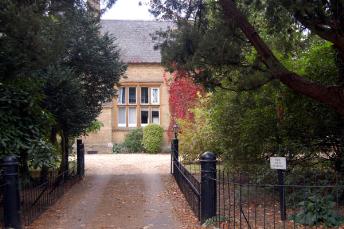
Former Old Warden School September 2007
The third of the great Education Acts was that of 1944 which established the principle of County Primary Schools for children up to the age of 11, at which time they took an examination to determine the nature of the secondary school they would attend until they were 15, the most academically able going to grammar schools, the rest to secondary or secondary modern schools. The act also created two types of successor to the public elementary schools - the Voluntary Aided and Voluntary Controlled schools. Voluntary Aided schools are those in which the Local Education Authority funds the school but the governing body is independent. Voluntary Controlled schools own their own buildings whilst the staff are employed directly by the governors. Old Warden duly became a Voluntary Aided County Primary School.
In the 1970s Bedfordshire County Council introduced comprehensive education, doing away with the 11+ examination and grammar schools and introducing a tier of school between the old County Primary and County Secondary Schools. Thus Lower Schools now taught children aged 4 to 9, Middle Schools from 9 to 13 and Upper Schools from 13 onwards. Old Warden became a Voluntary Aided Lower School but, due to falling rolls, and in common with a number of other small village schools in the county, it was closed in 1986.